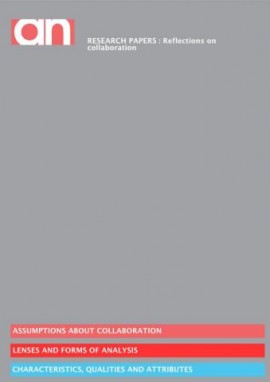
Code of Practice – Artists
A Code of Practice takes commonly-agreed principles of good practice and demonstrates why and how they should be applied.
A Code of Practice takes commonly-agreed principles of good practice and demonstrates why and how they should be applied.
Linda Ball explores how artists, makers and desgners can find work outside their artform.
Studio organisation Acme is behind a major project to investigate the socio-historical impact of the artist community in East London. A feasibility study now underway by design historian Sue Wilson aims to map the research process and establish the working […]
Artist as Leader is a programme that aims to understand the ways artists lead through their practice with a view to informing and developing a critical understanding of the role of creativity in culture.
Hannah Pierce, who has held curatorial and programming roles with organisations including The National Trust and Jerwood Visual Arts, offers advice and explores the key issues to consider when applying for a residency with non-arts organisations.
Whilst public art is distinctly ‘out of favour’ with Arts Council England cutting agencies as part of making savings, it’s interesting to see Creative Scotland taking a rather different tack.
Over seventy creative and cultural industries specialists participated in CreativeAmbition 2, the annual professional development event of the CreativePeople network.
Updated for 2008 Research papers, Indexing intelligence is a listing with live weblinks of accessible ‘facts and figures’, research studies, conference reports, publications and other resources that are pertinent to all those working in the visual arts, compiled and edited […]
Text-only version of a-n Research paper: Art work in 2007 with live weblinks.
Anne Douglas and Chris Fremantle of On The Edge Research share insights into the Artist as Leader research programme. The research aims to understand the way artists lead through their practice with a view to informing and developing a critical […]
As Anne Brodie’s Big Antarctica project blog draws to a close, C Moray de Morand’s compelling account of her Berlin residency is building up steam.
a-n’s former External Programmes and Partnerships Manager Hannah Pierce offers advice on the benefits to artists of mentoring and coaching, and highlights some of the differences between these two approaches to interaction and personal, professional development.
Dr Edwina fitzPatrick, course leader of the MFA Fine Art course at Wimbledon College of Arts, offers advice and explores the key issues to consider when selecting and applying to a postgraduate course.
Annabel Tilley talks to Gary Hume about twenty-five years of practice, prizes and paint.
Here, we profile a selection of courses offering postgraduate level study for artists seeking to develop their practice further within creative, supportive and critically challenging environments.
Chris Fremantle highlights key themes and issues around collaboration making use of a-n’s extensive archive of texts on the subject.
Although very many individuals now and in the past have given their best to or contributed hugely to a-n Magazine, with this the very last issue, I’d like to extend some special thanks: firstly to Gillian Nicol who started with […]
An abridged version of Dany Louise’s follow-up report on small visual arts organisations cut by Arts Council England, six months after her ‘Ladders for development’ enquiry. She asks: how have these organisations fared and what do their futures hold? Read the full version of this report with updates on all surveyed organisations: www.a-n.co.uk/realising_the_value
‘Ladders for development’ argues that the visual arts sector should pull together and support small visual arts organisations cut by Arts Council England because they “punch above their weight” and provide vital development of future artists. Six months on, Dany Louise interviews these arts organisations again, to find out how they’ve fared and what their futures hold.
Cara Courage examines the evidence about the gender imbalance in the arts workforce and asks whether it’s really down to women wanting to ‘have it all’.
After his show for New Work Scotland Programme at Collective Gallery, Edinburgh and before his solo show at Liverpool’s Royal Standard, Oliver Braid shares some thoughts on his career as an artist so far, including ideas on how to make a self-made residency and how to organise your own ‘graduate diary’.
‘W/Here: Contesting Knowledge in the 21st Century’, the 5th ELIA Leadership Symposium at Emily Carr University of Art and Design Vancouver, Canada (7-9 December) will bring together leaders from higher arts education institutions and universities across the globe for a […]
Joshua Sofaer asks what can culture do in times of wider crises.
Over the past five years, the words Turning Point have been read, heard, written and spoken with increasing frequency by people in the visual arts in England, but for many individual arts practitioners, in particular, the origins and activities of Turning Point remain a bit opaque. This briefing paper is for them and for anyone interested in understanding more about what Turning Point is and does.
In her report on Turning Point, Phyllida Shaw unwraps the ‘what’s what and who’s who’ of this major strategy for England, to support discussions on greater participation by, and development for, artists within it.














